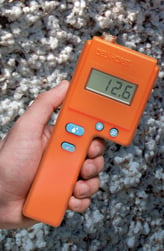 Cotton can be a fickle crop at harvest time. If your cotton in the field is too dry at harvest and processing, then you run the risk of damaging the fibers and ruining the cotton. On the other hand, cotton that’s too damp can stick to and clog your harvesting/processing equipment, causing damage.
Cotton can be a fickle crop at harvest time. If your cotton in the field is too dry at harvest and processing, then you run the risk of damaging the fibers and ruining the cotton. On the other hand, cotton that’s too damp can stick to and clog your harvesting/processing equipment, causing damage.
Just how narrow is the gap between too dry and too wet? According to the USDA, the recommended moisture content of cotton should be “8.0 percent—the recognized commercial ideal” and not lower than “at least 6.5 percent… Bales processed with less moisture yielded inferior yarn.”
This is a pretty narrow margin of error for producing top-quality cotton. So narrow, in fact, that trying to assess cotton moisture by hand is effectively impossible.
For this reason, before you start baling cotton, and especially before you start processing cotton, it’s important to use some kind of damp tester for cotton, such as a cotton moisture meter.
With a moisture meter for cotton, it’s possible to get an accurate, quantitative reading of cotton moisture so that you know for sure just how damp your cotton is.
However, cotton moisture meters work a bit differently from other kinds of moisture meters.
How do you use a cotton moisture meter? Here are a few easy steps to follow:
Step 1: Select and Attach Your Cotton Probe
There are a few different kinds of moisture meter probes that can be used for the testing of cotton. Small cup-style sensors such as Delmhorst’s 52-E/C electrode are generally useful for testing lint and seed cotton from the field that hasn’t been baled yet.
Using these sensors on cotton from random spots in the field can help you determine if your cotton is in the right moisture range to begin harvesting.
If you’re getting ready to test cotton bales that are getting ready to be processed, you’ll need a different kind of probe. Because cotton bales are large and dense, you’ll need a set of long, heavy-duty sensor prongs to get to the heart of the bale.
An example of an ideal bale-testing probe would be Delmhorst’s 30-E/C probe, which has 9 1/2” long insulated pins to test moisture at the heart of the bale without being influenced by surface-level moisture.
Depending on which type of electrode you’re using, the next step might change.
Step 2: Prepare to Take a Reading
Once you’ve got your sensor attached, it’s time to take a reading of the moisture content of your cotton.
If you’re testing lint and seed cotton with a cup-type sensor, you’ll need to remove a sample of cotton from a cotton plant for testing. It’s typically preferable to remove the seeds from your cotton prior to testing, since they can cause false high moisture readings.
Once you’ve got your sample of cotton for testing, push it into the top of the cup and compress it with your finger. Note that the sample should still overflow the top of the cup even after pushing it down. Now, just activate the meter and you’ll have a reading of the cotton’s moisture content.
The process for testing baled cotton should be familiar to those who have worked with hay moisture meters in the past. Here, you take the extended-length steel probe and stick it into the bale of cotton near the center. Once the probe is all the way in, activate the meter and take a reading. To ensure accuracy, you might want to take multiple readings from different angles, and average the results.
Making sure that the probe you use has insulated prongs helps prevent surface moisture from contaminating your reading results in a cotton bale.
With your reading results in hand, you should now be able to make an educated decision regarding what to do next.
For example, if your cotton samples are reading as having too little moisture, you can wet them down with a mixture of water and wetting solution to get the fibers to absorb a little more moisture so they’ll be ready for processing.
Step 3: Repeat as Necessary
Once you’ve taken your readings and have started baling or processing your cotton, it’s important to take more moisture readings throughout the day.
The %MC of cotton can change drastically from morning to noon as the sun dries out the field even as you harvest. Cotton stored in a bale can dry out if left in the heat as well.
By checking the moisture content of cotton periodically, you can make sure that your cotton isn’t getting too dried out during the harvest, keeping the quality of your fibers high.
Cotton can be a demanding, high-maintenance crop. But, with the right tools, you can control your cotton’s moisture and make sure that your fields produce the best possible fiber quality.

Comments